#tropical plant propagation
Explore tagged Tumblr posts
Text
Monstera Deliciosa Propagation and Care: A Complete Guide
Monstera Deliciosa, commonly known as the Swiss Cheese Plant, is a tropical houseplant adored for its large, glossy leaves and easy-to-care-for nature. In this article, I’ll walk you through the steps of caring for Monstera Deliciosa and guide you through its propagation, so you can grow new plants and maintain the health of your existing one. For a visual guide to propagation and care, watch the…
#growing Monstera from cuttings#houseplant propagation#how to propagate Monstera#indoor plant care#Monstera Deliciosa care#Monstera Deliciosa fertilizer#Monstera Deliciosa humidity#Monstera Deliciosa soil#Monstera Deliciosa tips#Monstera Deliciosa watering#Monstera in water#Monstera plant care#Monstera propagation#Monstera propagation guide#Monstera propagation in soil#Monstera root development#plant pest control#pruning Monstera#Swiss Cheese Plant care#tropical plant propagation
0 notes
Text









Wanted to show y'all how some of my plant babies are doing :)
#the last 2 im SUPER proud of cause i grew them from seed!! :)#plants#houseplants#cacti#tropical plants#propagations#my photos#plant babies#plantblr
11 notes
·
View notes
Text

🫙🌿 I've potted up the prop jar!
From my tall prop jar I had 3 philodendron silver sword cuttings and 3 philodendron verrucosum cuttings (initially it was one cutting that I further cut up because it had enough nodes - hence why the roots on one are a bit crazy)
I decided to put all 3 cuttings of each type into one pot because who doesn't love a chaotic and bushy philodendron!?
#plant blog#my plants#philodendron#silver sword#verrucosum#house plants#indoor plants#plant#plant photography#plant posting#plantblr#plantcare#tropical plants#houseplant#plantlife#potted plants#plant propagation#propagation
7 notes
·
View notes
Text
#dieffenbachia#plant care#houseplants#indoor plants#tropical plants#gardening#plant lover#plant enthusiast#plant parenting#houseplant care#plant advice#plant tips#how to care for a dieffenbachia#dieffenbachia plant care tips#dieffenbachia plant problems and solutions#dieffenbachia indoor plant#tropical plant care guide#personal experience with dieffenbachia#dieffenbachia plant styling#dieffenbachia plant propagation
1 note
·
View note
Text
One of my Philo. Florida Greens fell over tonight after a partial extension😭
Completely lost a new growth leaf that just came in, and half of a slightly older one.
However, this has promted me to chop and extend both of my FGs. I cut the stem on both already and will do the repot and extension tomorrow after work.
#plantproblems#plantparent#plant propagation#plants#foliage#houseplants#indoor plants#tropical plants#mosspoles#chopandextend#philodendronfloridagreen#sad#but blessing
1 note
·
View note
Text

Water roots tetrasperma raphidophora
1 note
·
View note
Text
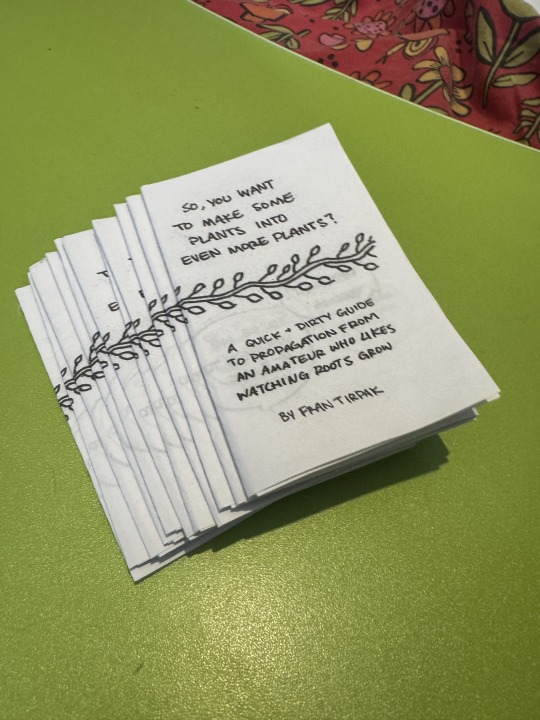
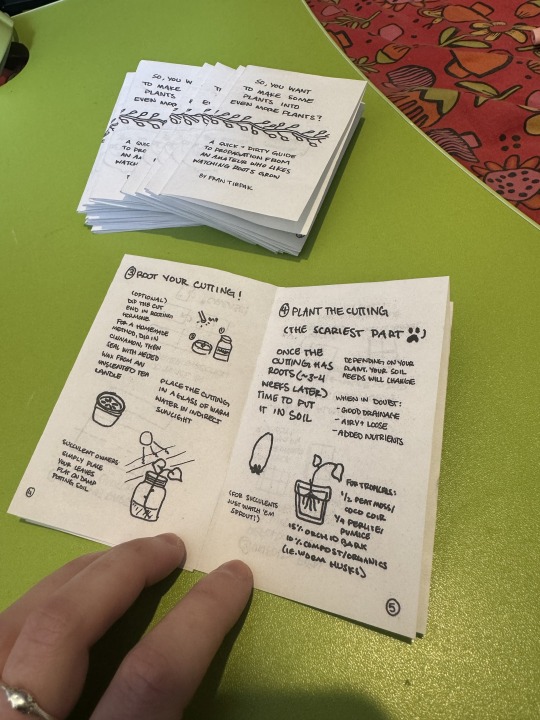
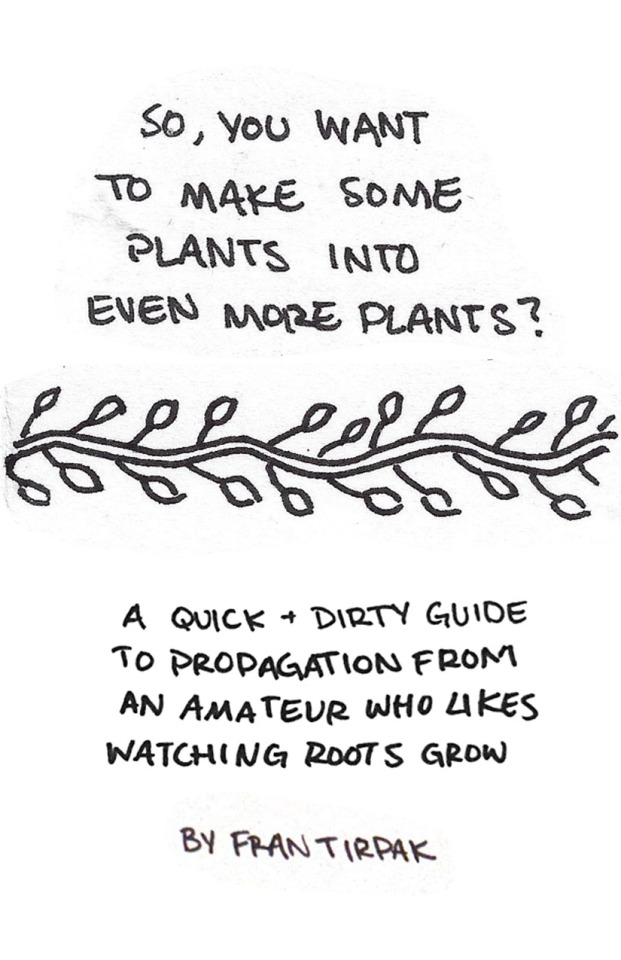
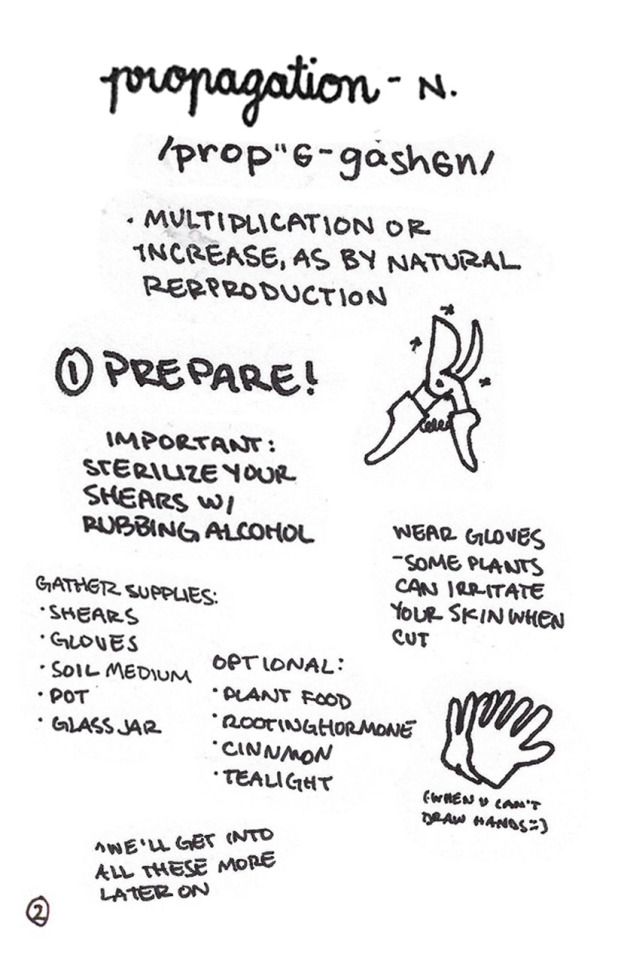
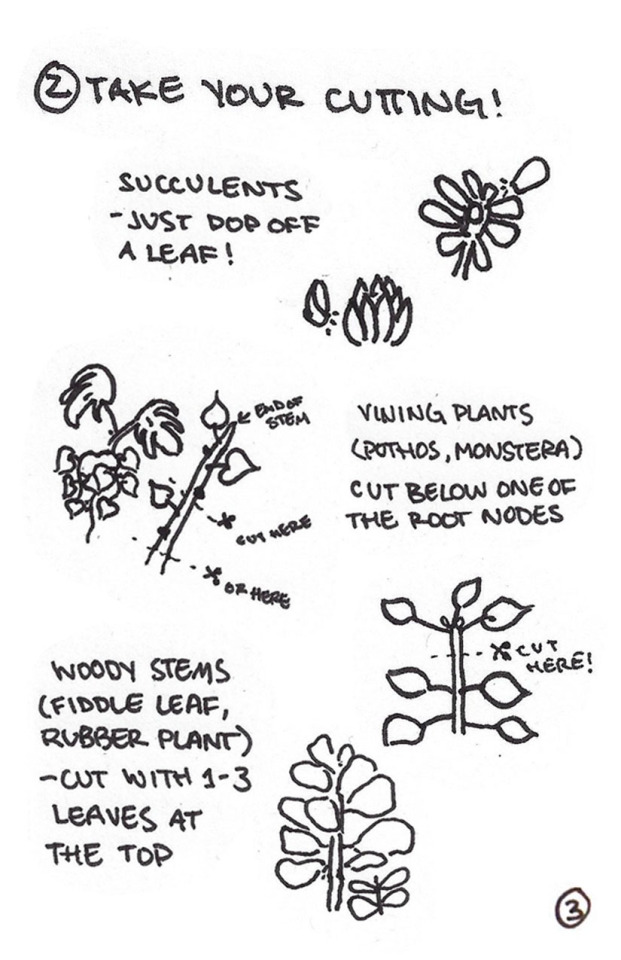
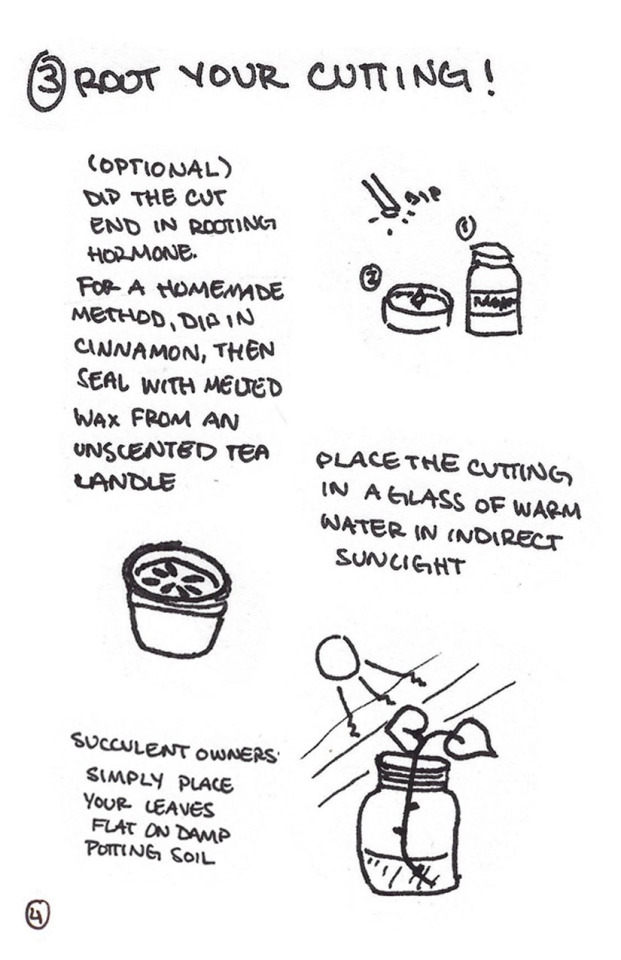
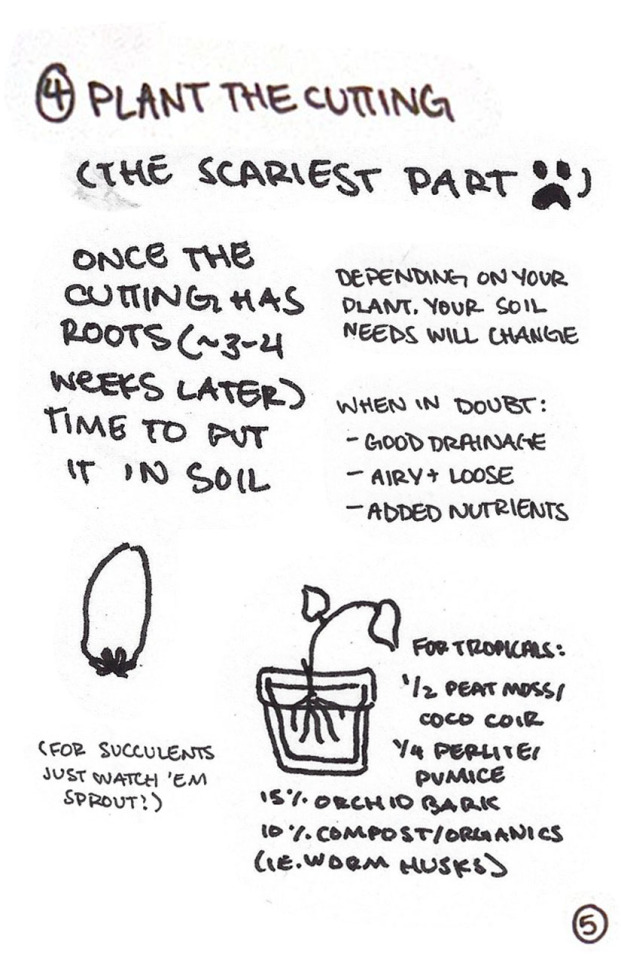
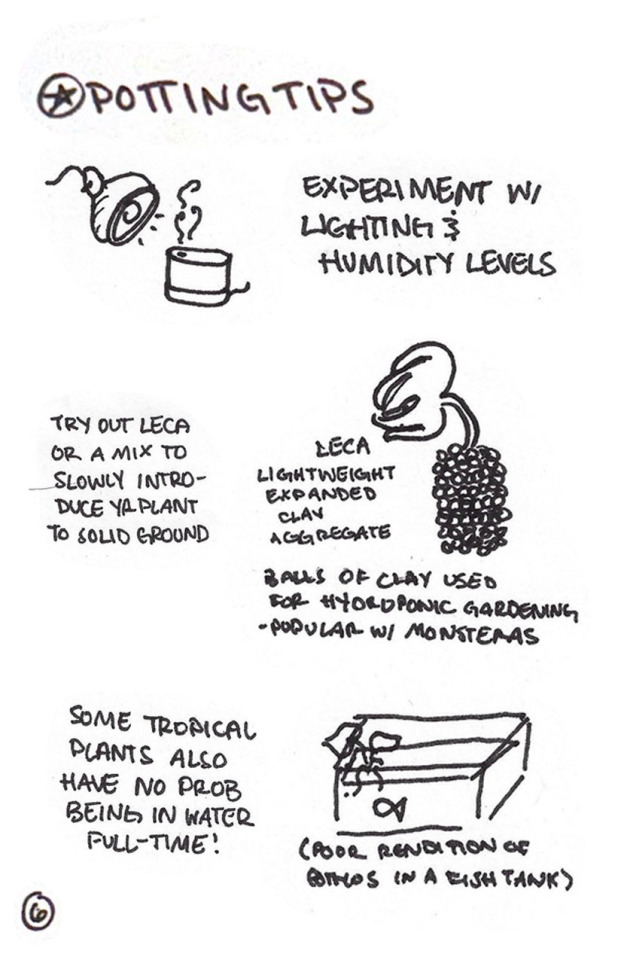


24-hour minizine (8 pages) about DIY propagation from leaf and stem cuttings (free to copy and distribute!! pls just take my name out if you change any content)
EDIT: thank you for all the love! check out @contentsunderpressurezine (instagram) for more of our stuff!
pdf download for print and read friendly versions on this ko-fi I just set up! pay what you wish, free to print and distribute
plaintext under the cut:
So You Want to Make Some Plants Into Even More Plants?
A Quick + Dirty Guide to Propagation from An Amateur Who Likes Watching Roots Grow. (by Fran Tirpak)
propagation - n.
"multiplication or increase, as by natural reproduction."
1. Prepare!
Important: Sterilize your shears w/ rubbing alcohol.
Wear gloves -- some plants can irritate your skin when cut.
Gather supplies: shears, gloves, soil medium, pot, glass jar.
Optional: plant food, rooting hormone, cinnamon, tealight.
^ we'll talk about these all more later on.
2. Take your cutting!
Succulents -- just pop off a leaf!
Vining plants (Pothos, Monstera), cut below one of the root nodes.
Woody stems (fiddle leaf, rubber plant) -- cut with 1-3 leaves at the top
3. Root your cutting!
(Optional) Dip the cut end in rooting hormone. For a homemade method, dip in cinnamon, then seal with melted wax from an unscented tea candle.
Place the cutting in a glass of warm water in indirect sunlight.
Succulent owners: simply place your leaves flat on damp potting soil.
4. Plant the cutting
(the scariest part)
Once the cutting has roots (~3-4 weeks later) time to put it in soil.
Depending on your plant, your soil needs will change.
When in doubt: good drainage, airy & loose, added nutrients.
For tropicals: 1/2 peat moss or coco coir, 1/4 perlite or pumice, 15% orchid bark, 10% compost/organics (i.e. worm husks).
(For succulents, just watch 'em sprout!)
* Potting Tips
Experiment with lighting and humidity levels.
Try out LECA or a mix to slowly introduce your plant to solid ground.
LECA: Lightweight Expanded Clay Aggregate. Balls of clay used in hydroponic gardening - popular with Monsteras
Some tropical plants also have no prob being in water full-time!
5. Now you have a friend!
Pro tips: You can take props from anywhere (as long as you're responsible -- and sneaky).
There's no one way to care for a plant. Do your research, go with your gut, & have fun!
129 notes
·
View notes
Text

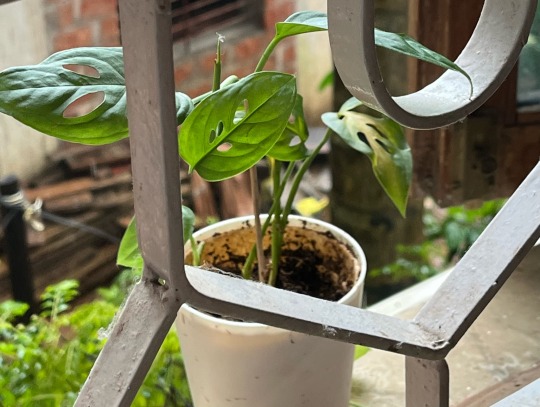
Monstera deliciosa 🪴
Information -
Kingdom: Plantae
Order: Alismatales
Family: Araceae
Genus: Monstera
Species: M. deliciosa
Monstera deliciosa, the Swiss cheese plant or split-leaf philodendron is a species of flowering plant native to tropical forests of southern Mexico, south to Panama.It has been introduced to many tropical areas, and has become a mildly invasive species in Hawaii, Seychelles, Ascension Island and the Society Islands. It is very widely grown in temperate zones as a houseplant.
It is called Swiss Cheese Plant due to their natural leaf holes. The Monstera plant's scientific name, Monstera deliciosa, derives from the Latin words "monstrum" meaning "monster" and "deliciosa" meaning "delicious."
Monstera plants are natural detoxifiers. Their broad leaves absorb and strip away indoor air toxins. The ideal temperature it requires is around 70°F. With a little humidity added to that, they get to feel right at home. Monsteras need bright light but do not tolerate direct sunlight. They can survive in low light, but their growth will be inhibited. To grow a striking Monstera plant with the lacy leaves and the coloration you adore, you need to provide it with good light. Monstera prefers bright indirect light. Keep out of direct sunlight for extended periods, as it can burn the leaves.
It is safe to come into skin contact with Monstera soil, foliage, and stems. However, it is not safe to ingest any part of the plant. Monstera is mildly toxic to humans and is toxic to cats and dogs but is not considered lethal. All parts of the plant are harmful to ingest except the fully ripe fruit, which rarely develops on indoor Monstera. The toxicity comes from insoluble oxalate crystals in the juices inside the plant. Indoor Monstera Deliciosa doesn’t yield fruits.
In various cultures, the Monstera has been a beacon of good luck, protection, and prosperity. It also fills spaces with positive energy and attracts good luck, according to Feng Shui.
Tips to grow and maintain Monstera:
Light: The plant thrives in bright and indirect light. It is advisable to keep it on a windowsill that receives good amount of indirect sunlight. Direct sunlight may burn its leaves. Note, if you find the leaves have small or no holes, then it means that the plant is not getting adequate light.
Soil:Use soil that retains moisture. Peat moss, perlite, and compost helps in the plant growth.
Watering: Ensure that Monstera Deliciosa is planted in a pot with good draining facility. The right time to water the plant is when the soil looks dry at the top. Note, overwatering may lead to root rot. During summers, the plant needs water regularly, however decrease the frequency of watering during winters.
Humidity: This plant grows well in humid conditions. You can mist its leaves or place it in a water tray having pebbles to increase the humidity level around it.
Temperature: Monstera Deliciosa grows well between 18°C and 29°C.
Support: As Monstera Deliciosa is an understory plant with aerial roots and large leaves, it needs support to grow.
Pruning: Prune the plant to maintain its shape. Remove yellow or damaged leaves so that the plant grows well.
Propagation: Monstera Deliciosa can be propagated through stem cuttings that can be rooted into water or directly planted into soil. You can also choose the process of air layering that involves creating a root system in a mature stem when it is still attached to the mother plant. Once roots are developed, the stem can be separated.
#plantblr#plantcore#plant photography#plants#plantbased#plant blog#monstera deliciosa#monstera plant#writerscommunity#spilled ink#dark academia#light academia#photographers on tumblr#photoblog#beautiful photos#photo#photooftheday#photography#leaves#green#naturecore#nature#planting#trees#flowercore#flowers#information#botany#biology#forest
23 notes
·
View notes
Text
Pretty Pink Plants

(Disclaimer- I'm not a professional gardener, these are just some plants I thought were pretty and researched slightly. If you're looking into becoming a plant parent then I recommend you research these plants some more.)

Calla Lillies
Calla Lillies can live both indoors and out. For them to prosper inside, they must be potted in moist soil and kept in rooms that range from 60-80 degrees Fahrenheit, along with being exposed to a decent amount of light.

String of Hearts
String of hearts is an easy plant to grow indoors and serves as a cute plant you can hang or place on shelves, and they can also be propagated.

Polka dot Plants
Polka dot Plants thrive both indoors and outdoors, growing best in rich soil and indirect amounts of sunlight. Similarly to the String of Hearts, it too can be propagated.

Pink Lilies
Pink Lilies can survive both inside and out. They prefer humid environments and need to be watered about once a week.

Tulips
With the proper care, tulips can grow indoors, in fact they can be grown in glass vases. The plant most commonly kept outdoors live best in a sunny yet cool room, and if potted should be watered 2 to 3 times a week to keep the soil moist.

Fuchsias
Though Fuchsia’s are mostly outdoor hanging plants, ideal for deck and porches, they can be grown inside with proper moister and indirect sunlight and can serve as a lovely way to liven up a room.

Pink Princess Philodendrons
Pink Princess Philodendrons can be grown indoors and more commonly thrive in humility and indirect light. The plant can easily be propagated.

Calathea White Stars
Calathea White Stars prefer indirect sunlight and can live in tropical environments and indoors. It's somewhat difficult to grow, most commonly requiring a draining soil mix and can propagate as well.

Peonies
Peonies can live indoors, serving as a cute decoration in any room although they require about 5 to 6 hours of sunlight daily, so remember to keep them in a sunny room.

Astilbe
Astilbes can be grown indoors and outdoors, but if you consider growing them indoors, place them in a spot where they can get about 4 to six hours of sunlight daily.
#girlblogging#girlhood#pink#i’m just a girl#pink aesthetic#pink blog#pastel pink#that girl#just girly posts#just girly things
22 notes
·
View notes
Text



This is my home nursery. This is also where I do tree propagation and grow native plants from seed. When the plants are strong and healthy I transport them to the Mojave property.
You are looking at trees, shrubs, herbs, succulents and berries for our restoration project in the Mojave desert.
2 Palo verdes, 5 mesquites, several native Mojave shrubs, 1 oak, 3 desert pines, 1 olive, 4 fig, 1 apple, 1 persimmon, 1 jujube, 1 banana, 1 loquat, 1 mulberry.
The tropical trees will most likely go in a shade house I will be building in the fall.
I’m still saving for more native trees for the next pocket forest in October . If you’d like to be part of the next tree planting or seed ball dispersal contact me.
18 notes
·
View notes
Text
How to Care for Philodendron Fuzzy Petiole?
Philodendron Fuzzy Petiole is a captivating, relatively new species in the Philodendron family. This tropical beauty, thought to be a form of Philodendron nangaritense, is known for its lush foliage and unique fuzzy petioles. Native to the Amazon rainforest in countries like Brazil, Colombia, Ecuador, and Peru, it thrives in warm, humid environments, making it ideal for indoor plant lovers who…
#best soil for Philodendron#fuzzy stem philodendron#growing Philodendron indoors#houseplant pest control#how to care for Philodendron Fuzzy Petiole#humidity tips for tropical plants#indoor Philodendron care#light requirements for Philodendron#Philodendron care guide#Philodendron fertilization tips#Philodendron Fuzzy Petiole#Philodendron Fuzzy Petiole care#Philodendron Fuzzy Petiole humidity needs#Philodendron Fuzzy Petiole propagation#Philodendron Fuzzy Petiole watering#Philodendron leaf growth tips#Philodendron nangaritense care#rainforest plants indoors#repotting Philodendron Fuzzy Petiole#tropical plant care
0 notes
Text

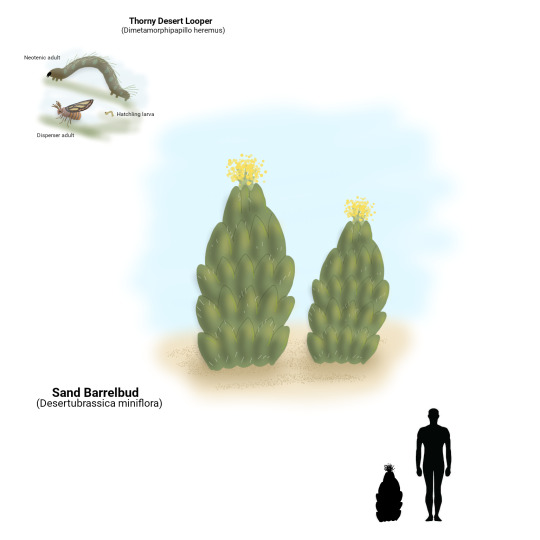
Sand barrelbuds (Desertubrassica miniflora) are a strange, hardy cabbage descendant found across the drier regions of Gestaltia and Arcuterra, where they grow in savannahs, semi-deserts, arid scrubland and other dry regions with little rainfall where their water-retaining abilities allow them to flourish.
These resilient plants sport short, stocky stems and rings of thick waxy leaves: adaptations that allow it to reduce moisture loss and store as much water in its tissues, stockpiling its reserves during brief and infrequent rains. Its roots, twice as long as its three to four-foot trunk, burrow deep into the soil in search of groundwater seeped into the ground, and, like many desert plants, exploits the window of time when the rains come in order to bloom. Its flowers are clustered and cauliflower-like, producing thousands of seeds per blossoming--which, in the harsh and unpredictable natures of its home range, few of which will survive.
Barrelbuds, at times the only reliable source of nutrition in many of its native regions, are home to various insects that depend on it for food, moisture and shelter from predators and the hot suns, most notably the thorny desert looper (Dimetamorphipapillo heremus), a species of caterpede that, like most of its kin, are neotenic creatures that never pupate and turn into moths: instead maturing into a form that is merely a larger two-inch larva with functional gonads that can mate and lay eggs. Unlike its relatives, however, thorny desert loopers possess thick outer cuticles with defensive spiny hairs, in order to withstand the dessicating conditions of the arid tropical scrublands. They too have another distinction: they give birth to live young, producing batches of up to a dozen tiny first-instar larvae at a time that hatch from eggs inside their bodies, born already thick-skinned and able to resist dehydration upon being born and able to acquire and store moisture right away.
But perhaps the greatest deviation the thorny desert looper has from other caterpedes is that it retains an ability to metamorphose if need be: producing a stunted, short-lived adult moth disperser from latent genes that can activate in an emergency--yet having already lost the genetic mechanisms to produce a proper adult form. This vestigial remnant stage is a poor flyer, and lacks mouthparts that would allow it to feed: yet this is sufficient to fulfill its sole mission as a last-resort propagator. When colonies of thorny desert loopers become too large, the increase of pheromones produced by others signal the threat of overcrowding, and triggers a few larvae at the final pre-adult instar to pupate and emerge as winged dispersers. These merely flutter off to nearby plants, deposit their clutches of only a handful of eggs, and die immediately afterwards, having an imago lifespan of just a day or two: but enough time to seed new colonies onto new territories when their host plant begins to be overwhelmed.
-------
#speculative evolution#speculative biology#spec evo#speculative zoology#hamster's paradise#ask#species profile
67 notes
·
View notes
Text
Jar-check Chronicles: A Peek into My Propagation Wonderland 🌱✨
Today, let's take a journey into the world of propagation jars! 🌱✨ Propagation jars are something I recently started experimenting with. For the longest time I have stuck with the tried and true water jar propagations or soil tray method. However, I recently acquired a number of new cuttings that I thought might benefit from a bit of extra humidity.
Now, some people might say to not bother the props and just let them do their thing... but:
I am too curious/have no self control
Like to check up on moisture levels and root health.
So let's take a look at what's in the jars!

🌱Jar 1:
This little jar has become home to my alocasia corms. I have 3 larger corms here from an alocasia poly that I recently repotted into semi-hydro and they have been in here for almost two weeks now. These guys are looking great! I can see some roots coming off of the corms and I will probably give them another couple of weeks before potting them up. There are also a couple of little silver dragon corms in here. They're not super visible in the sphagnum moss and they might be a bit too small to really do anything. But we shall see 🤷♀️

🌿Jar 2:
These are some cuttings and wet sticks that I got from some recent swaps! It also just so happened to turn into the philodendron jar (this was not planned... just a happy coincidence).

I have two silver sword cuttings and a wetstick. These guys have been in here for 3 weeks now and I'm starting to see some roots and new growth! They're still pretty small so I imagine they will be in here for at least another month
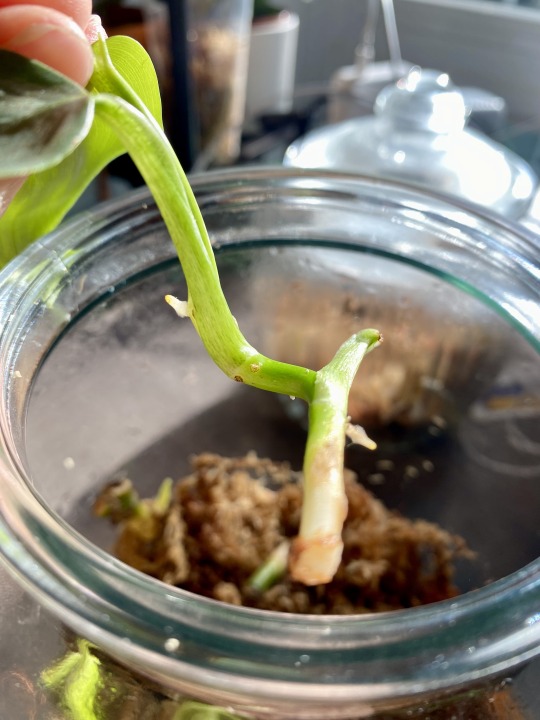
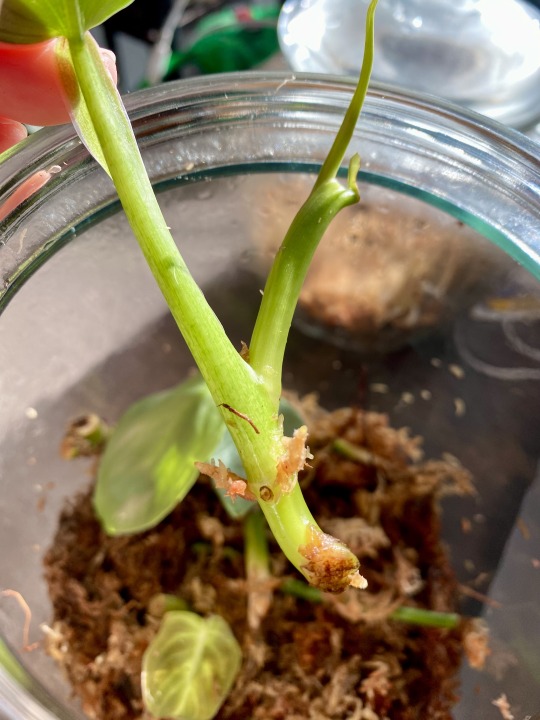
I also have a melanychrysum cutting that has been in here for two weeks now. I'm not fully confident that this little guy will survive. He was a bit rotty on the ends of the wetstick and his little leaf is struggling. There is a bit of root action but he's still going to live in the jar for the foreseeable future. I'll also keep monitoring his ends for signs of rot. If they continue to go downhill I'll likely treat with a diluted hydrogen peroxide dip.
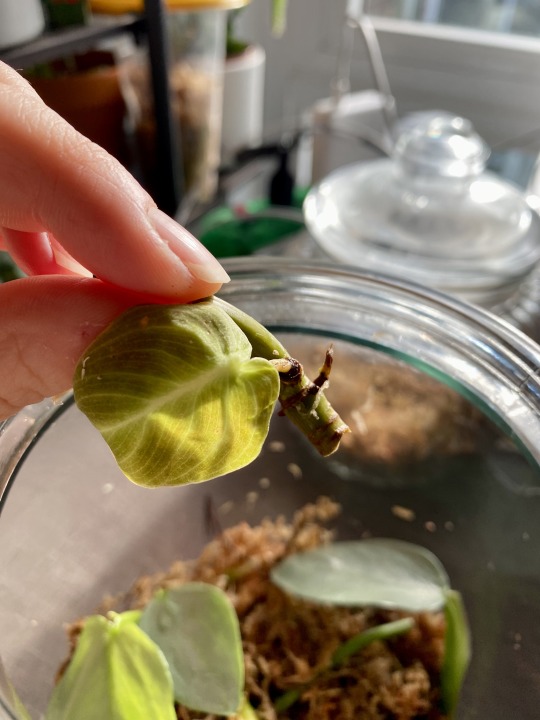
And, finally, we have a verucosum wetstick. This guy came as part of a larger cutting that has now been split into 3 sections. I don't really know why but his midsection ended up in a starbucks cup with moss and perlite and his top end, which has a leaf, is in a water jar. This end isn't seeing a ton of action but he's only been in the jar for a week, so I wouldn't have expected much. His starbucks cup brother already had some crazy roots and is starting to put out something (I'm not too sure if it's a root or a leaf)
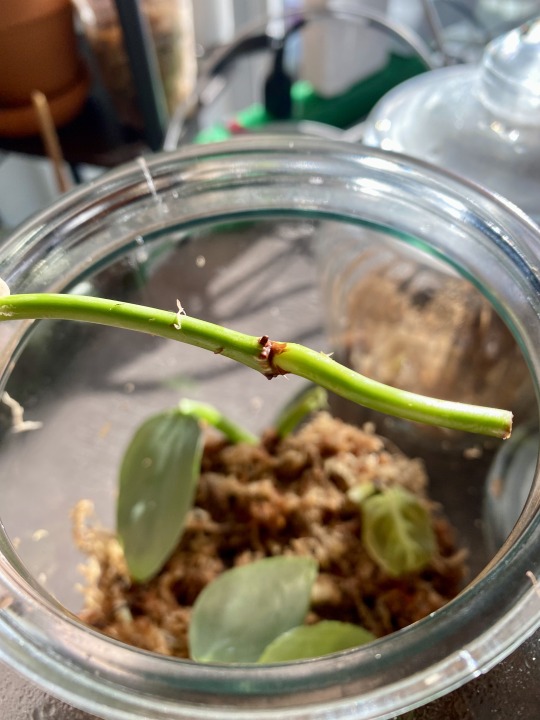
So far this has been such a fun little experiment. If anyone sees this reblog and show me your little prop jar worlds 🌿💚
#plants#propagation#JarCheckChronicles#aroids#tropical plants#houseplants#gardencore#philodendron#silver sword#rare plants#plant propagation#propagation jar#my plants#oc
5 notes
·
View notes
Text
What I studied today!
09.08.2024
Identification and Classification of Marine Angiosperms:
Zostera marina, Nanozostera noltei and Cymodocea nodosa
Marine angiosperms such as Zostera marina, Nanozostera noltei, and Cymodocea nodosa play a crucial role in coastal ecosystems by providing habitat and nutrients for marine life. Their identification can be challenging due to similar appearances.



Morphological Differences
Zostera marina: is a perennial seagrass species widely distributed in temperate marine waters. It typically features long, narrow, ribbon-like leaves that can extend up to 2 meters in length. The leaves are linear, with a width ranging from 1 to 2 mm, and are characterized by parallel venation, which is subtle and not prominent. The stems, or rhizomes, are usually greenish or light brown, and the plant forms dense underwater meadows. Zostera marina reproduces through both sexual and vegetative means, producing small, inconspicuous flowers and asexually propagating via rhizome extension.
Nanozostera noltei: commonly known as dwarf eelgrass, is a smaller seagrass species found in shallow, brackish, and coastal waters. The leaves are relatively short and broad, typically measuring 20 to 30 cm in length and 1 to 2 mm in width. Unlike Zostera marina, the venation of Nanozostera noltei is more pronounced, giving the leaves a more textured appearance. The rhizomes are darker green to brown and less robust than those of Zostera marina. This species is adapted to higher salinity fluctuations and often forms mixed meadows with other seagrass species. Reproduction occurs through both flowering and rhizome propagation.
Cymodocea nodosa: is a seagrass species predominantly found in tropical and subtropical marine environments. It is characterized by its coriaceous, thick, and rigid leaves, which are typically 15 to 30 cm long and 1 to 2 cm wide. The leaves display a distinct reticulate venation pattern, with well-defined, thick veins running parallel and intersecting, creating a net-like appearance. The stems are lighter in color, ranging from pale green to yellow, and the plant forms extensive, dense meadows on sandy substrates. Cymodocea nodosa primarily reproduces through vegetative means by spreading rhizomes, although it also produces small, inconspicuous flowers.
Syntassonomic Classification
In syntassonomy, which classifies and describes plant communities based on ecological and floristic criteria, the following terms are used:
Class: Represents a broad unit of classification for plant communities, grouping together different alliances that share similar ecological and climatic characteristics. Examples include the classes Zosteretea marinae and Ruppietea maritimae.
Order: A subdivision of the class, grouping alliances with more specific ecological affinities. Orders, such as Zosteretalia marinae and Ruppietalia maritimae, include alliances that share particular environmental conditions and ecological dynamics.
Alliance: A category within the order that includes plant communities with common dominant species and similar environmental conditions. Alliance group together associations with comparable floristic and ecological characteristics.
Difference between alliance and association
Alliance: A broader category that groups together different associations sharing common ecological and floristic characteristics. It represents an aggregation of several associations with similar ecological structures.
Association: The most specific unit in syntassonomy, representing a distinct plant community found in specific environmental conditions with a well-defined species composition. Associations are the actual plant communities observable in the field.
#studyblr#study blog#studyspo#study motivation#studying#study aesthetic#studying aesthetic#uni studyspo#uni studyblr#uni blogging#uni student#university#stem girls#stem studyblr#stem academia#stemblr#women in stem#stem#stem student#student blog#student#it girl#that girl#clean girl#becoming that girl#glow up tips#hyper feminine#healthy girl#pink pilates girl#this is what makes us girls
15 notes
·
View notes
Text

Confusingly called "Peruvian black mint" in culinary circles, Huacatay is a species of Andean marigold used in traditional cooking and herbal medicine in Peru, Bolivia, Ecuador, and Chile. The flowers are tiny but the leaves are where the magic happens! The fern-like leaves have large oil glands on the undersides containing an exhilarating flavour akin to mint, cilantro, tropical flowers, and passionfruit swirled together. The fresh or dried leaves are ideal for dishes from Mexican cuisine where one would normally use cilantro. This plant has been used to treat stomach issues, respiratory discomfort from colds, and bacterial infections. Medical research supports Huacatay's use as an anti-inflammatory. Once established in the springtime via heated propagation, Huacatay is low maintenance thrives in the Southern UK outdoors until the November frosts hit, and it will keep growing in an unheated greenhouse through January. Highly recommended!
#katia plant scientist#botany#plant biology#plants#plant science#herbs#huacatay#peruvian food#latin america#gardening#plant facts
11 notes
·
View notes
Text
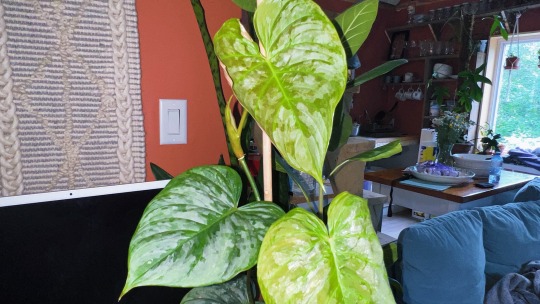


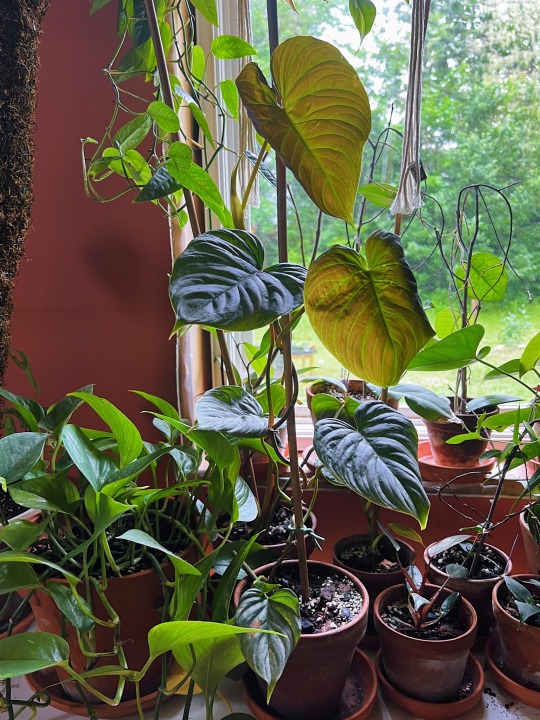
Not too bad for a neglected plant. This Philodendron Majestic (Sodiroi x Verrucosum) needs a moss pole so bad but I’m too lazy to make one and to repot 😬
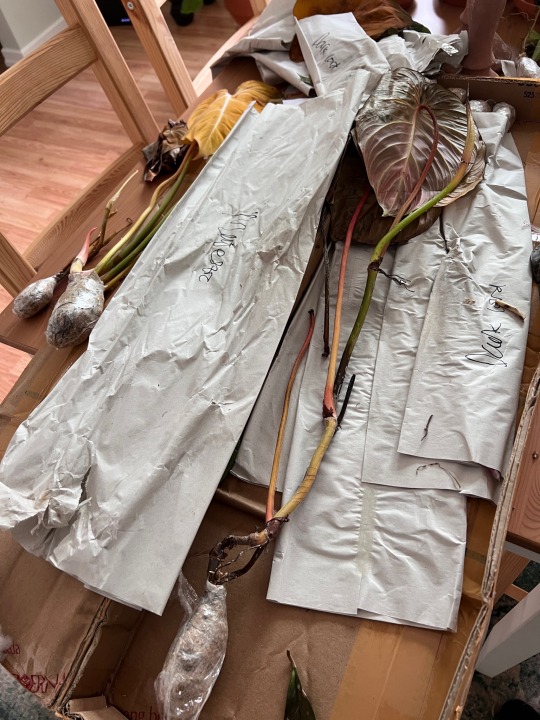
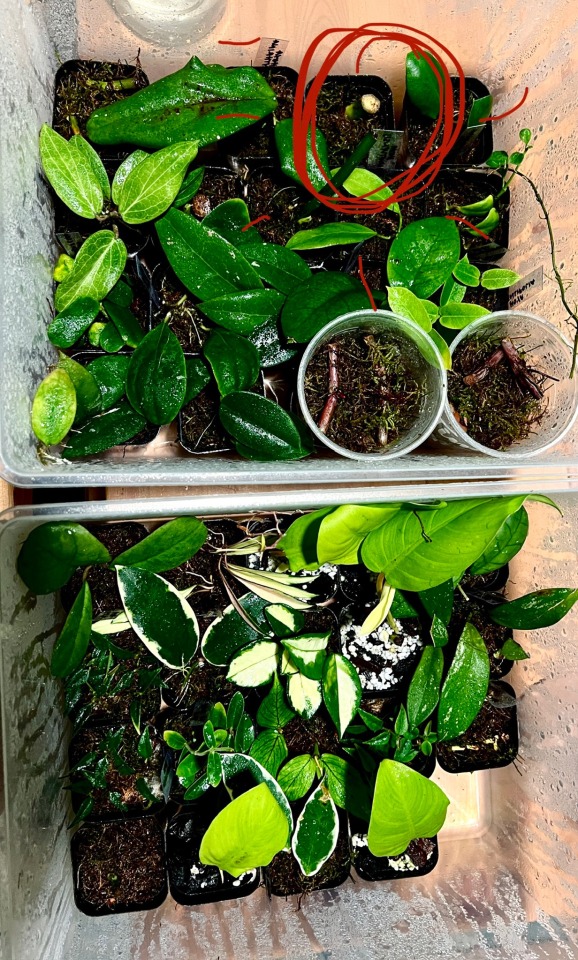
I imported this from Indonesia way back in August of 2022. The whole order was basically dead so I just chopped the individual nodes and dumped it all in a propagation box with moss as a medium. Between the building the house, moving, seasonal depression, among other things, I neglected the box. I did not check it for over half a year.
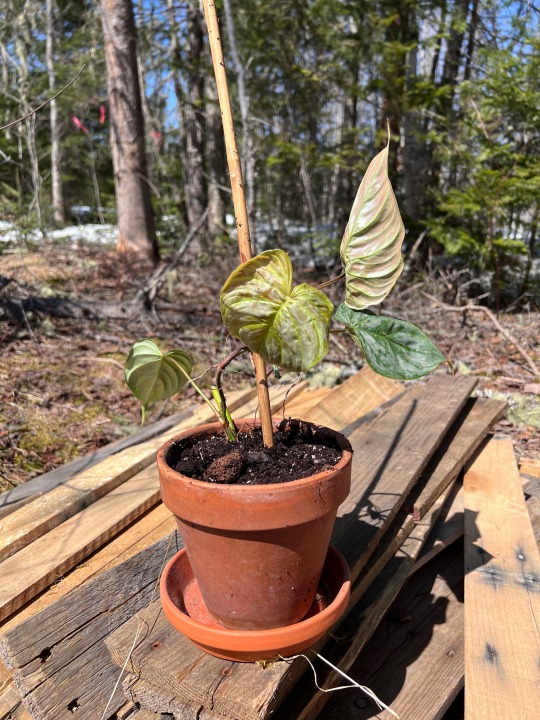
April came along and I finally took care of the box and to my surprise, every single type of plant that I originally ordered sprouted. Yay! I repoted them but as the weather got warmer, I focused 100% of my time on my outdoor garden. It seems like these tropical plants loves being neglected. I have the Atlantic coast high humidity to thank.
17-Jul-2023
#philodendron majestic#philodendron#tropical plants#house plants#plantblr#indoor garden#indoor plants#houseplants#houseplant#plant community#plant blog#plants#plant aesthetic#botany#indoor jungle
65 notes
·
View notes